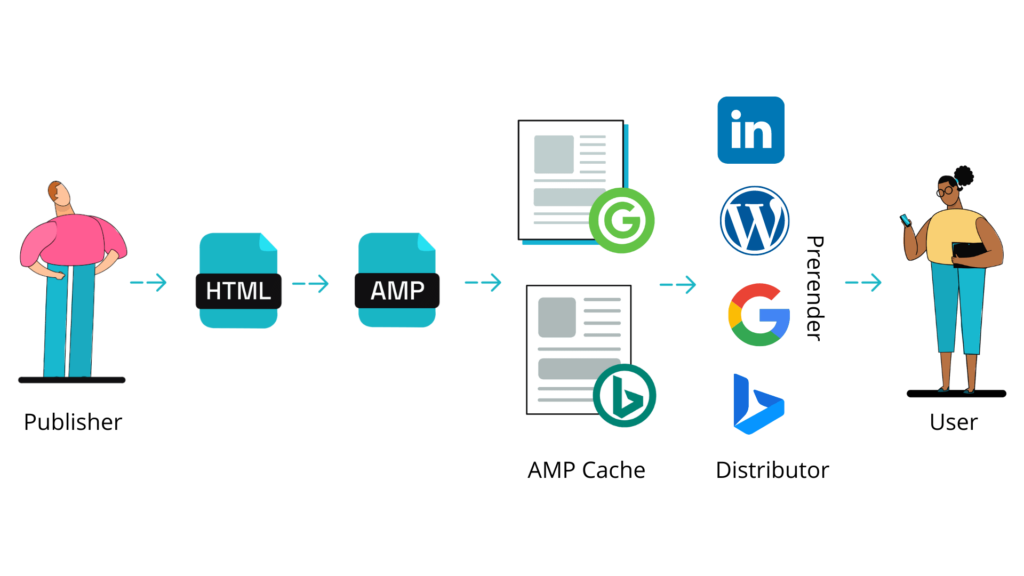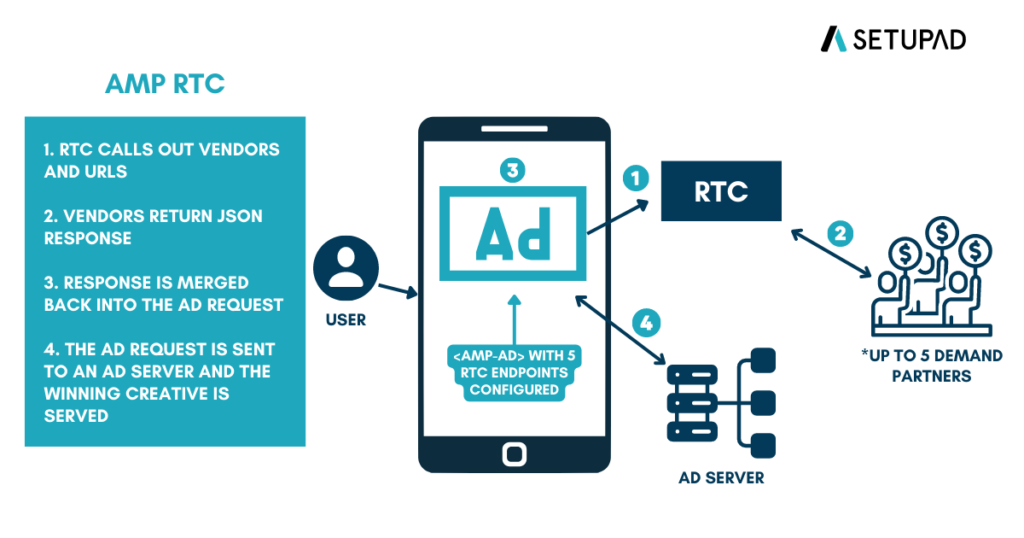Header Bidding on AMP – A Guide for Publishers
In February 2016, Google unveiled the open-source Accelerated Mobile Pages (AMP) platform. It was developed to replace the complex and slow mobile experiences that users regularly encountered.
There are two choices for header bidding on AMP–RTC alone or combined with a header bidding wrapper.
In this article, you will understand AMP and find the best way to combine it with your header bidding strategy!
What are Accelerated Mobile Pages (AMP)?
Accelerated Mobile Pages (AMP) is an open-source project designed to improve the performance of web pages for mobile devices.
Google initiated the AMP project to develop a framework that would outline precisely how to produce optimized mobile web page experiences.

AMP is developed using specific technologies and guidelines to ensure they’re lightweight and efficient. They provide a better user experience for mobile users by reducing page load time.
AMPs use a subset of HTML and optimize for performance. They use a limited set of CSS styles and JavaScript (JS) and are designed to be cached on the web so they can be served quickly to users.
AMPs are also designed to prioritize loading content immediately visible to the user rather than loading all content on the page at once, decreasing the chance of page latency.
They’re supported by various platforms (e.g., Google, Twitter, Pinterest, LinkedIn) and are intended to improve the performance and usability of web pages.
AMP benefits publishers who want to ensure their content loads quickly and smoothly.
- How to set up Google AMP?
Accelerated Mobile Pages use a small amount of JS and HTML.
You can create AMP versions of your landing pages using the AMP HTML format and AMP JS. Use the Google Ads developer guidelines for AMP to get started.
If you already have a blog running, it’s compatible with practically all CSS by providing a simple plugin.
AMP implementation is much simpler than you may imagine for websites running WordPress. Be sure to check our guide on how to implement Google AMP for WordPress for clear instructions!
Simply put, this process includes installing one or more AMP plugins (depending on the one you select), personalizing the appearance and feel, and making other adjustments that fit your needs.
What is Real-time Configuration (RTC)?
The AMP team introduced Real-Time Configuration (RTC) as a Fast Fetch feature 2018 as an alternative to conventional header bidding for AMP. Fast Fetch is an AMP feature that was launched in the middle of 2017 to render ads more quickly.
RTC allows the extension of the demand to compete for an ad slot with AMP.
RTC has a maximum timeout of 1 second and lets publishers connect with up to 5 demand partners. After the timeout period has passed, RTC examines the bids received and asks the ad server to show the winning creative.

How to Implement Header Bidding on AMP?
Because of the AMP framework’s restrictions on unique third-party JS tags, publishers may find it challenging to monetize AMP.
These restrictions also made it impossible to use header bidding on AMPs. But as the need for greater AMP monetization support grew, AMP created RTC.
RTC allows publishers to link up to five demand partners, simulating a header bidding system.
Another option is to set up a header bidding wrapper, which allows to extend the amount of demand partners, but we’ll cover that in more detail later.
Here are 6 main steps to implement header bidding on AMPs:
- Select a header bidding system that works with AMP (e.g., Prebid.js).
- Configure your AMP pages using the header bidding solution. Usually, you’ll need to add a few lines of code to the AMP HTML head section on your website.
- Create AMP-compatible ad units. These ad units will display the ads served through your header bidding setup.
- Configure your header bidding partners. This typically involves adding the partner’s integration code to your website and specifying the ad units you want to bid on.
- Check the configuration to ensure everything is working properly. You should verify that bids are being received and that ads are being served properly.
- Optimize the setup to maximize revenue! This includes adjusting the timeout settings, adding or removing partners, and testing different ad formats.
AMP limitations
To increase the page load times, the majority of analytics tracking and ad serving scripts are removed by AMP. This makes it difficult for publishers to identify and monetize their audience.
As a result, many early adopters removed AMP from their websites. But Google improved AMP to eliminate these worries.
For example, the Fast Fetch rendering function allows advertising on AMP to be fetched asynchronously and only render when consumers are likely to view the content.
Here are 3 main limitations to AMP:
- Limited number of demand partners (up to 5 with RTC).
- Only one demand partner out of the five is permitted to sync cookies.
- The loading of content through AMP is very difficult. Due to their frequent inability to provide scalable infrastructure to support both the content and adverts simultaneously, many publishers struggle to properly monetize their websites.
Pros and Cons of Using AMP with Header Bidding
Here are the 4 main pros of using AMP with header bidding:
- Improved performance and user engagement. Pages built with the open-source AMP project load almost immediately, providing users with a seamless, more engaging experience on their mobile devices and desktops.
- Range of ad formats. AMPs support a wide range of ad formats, including display, video, and native ads, which can give publishers flexibility in their ad placements.
- Page loading speed. AMP’s short page load times may indirectly boost search engine ranks and increase organic traffic from Google because website speed is considered a ranking factor (e.g., Core Web Vitals).
- Increased ad revenue. Using AMP with header bidding can help increase ad revenue by improving the performance and efficiency of the header bidding process.
Here are the 3 main cons of using AMP with header bidding:
- Limited ad options. Some advertisers may not support AMPs, which could limit the demand sources available to publishers using AMPs with header bidding.
- Complex setup. Implementing AMPs with header bidding can be complex and require a high level of technical expertise.
- Limited control. AMPs are optimized for performance, which can result in a limited ability to customize the look and feel of the pages.
| AMP header bidding | |
| Benefits | • Increased competition for ad inventory. • Improved ad visibility and user experience. • Faster page load time. • The ability to work with multiple ad exchanges and demand sources simultaneously. |
| Drawbacks | • Increased complexity of the ad delivery process. • Requires a high level of expertise due to the complex setup. • Limited page customization. |
Overall, AMP header bidding can help improve the performance and efficiency of the header bidding process and increase ad revenue. Still, it may also involve some limitations on ad options and require a complex setup.
Real-time Configuration (RTC) Header Bidding Approach
RTC is optional, and it can only call five demand partners. To raise demand, you need a header bidding wrapper.
Using AMP and header bidding wrapper allows to go around the AMP limitations and add as many demand partners as necessary.
When employing a header bidding wrapper, the RTC framework is necessary to raise bids and competition among demand partners. The wrapper and dashboards let you perform anything from administration to reporting and connecting to multiple demand partners.
The wrapper should utilize server-side bidding to execute auctions smoothly and provide RTC.
The majority of managed header bidding partners can handle your setup and implementation. Therefore, as a publisher, you don’t have to deal with any of the implementation and development efforts of setting up a header bidding wrapper.
Which header bidding solutions are compatible with AMP?
Multiple header bidding solutions are compatible with AMP.
For example, a managed monetization platform like Setupad can help display AMP ads with a header bidding wrapper.
Publishers should consider their needs and capabilities before choosing a header bidding solution that meets their requirements.
Here are 5 more header bidding solution providers that are compatible with AMP:
- AppNexus.
- Index Exchange.
- Criteo.
- Amazon Publisher Services (APS).
- Google Ad Manager (GAM).
Header bidding wrapper approach
As already mentioned, working with a partner who offers a header bidding wrapper with AMP support is another option for AMP header bidding.
Due to the nature of AMP, only wrappers with server-to-server integration function properly, and AMP will more likely block client-side implementations during runtime.
By sending bids across a single RTC slot, wrapper-based header bidding surpasses the 5 demand partner limit. As a result, publishers are free to add as many demand partners as they choose.
However, there are additional benefits to employing a wrapper-based approach.
Publishers require a developer to make updates using RTC and its single tag method each time they wish to add or delete a demand partner.
On the other hand, a header bidding wrapper enables publishers to make these changes from a user-friendly panel.
Additionally, wrappers give publishers reporting and analytics data, which RTC doesn’t currently support.
Wrapper vs RTC
Having to choose between a header bidding wrapper or RTC needs to be corrected. If you want to use the wrapper, RTC is required. Therefore, you have two options–utilize RTC by itself or combine it with a header bidding wrapper.
RTC benefits small publishers who want to receive bids from a specific group of demand partners.
The header bidding wrapper is the one to choose if you require reporting, simple management, and fierce competition. Therefore, RTC alone and RTC combined with a server-to-server header bidding wrapper are the correct options you could choose from.
AMP vs. Facebook Instant Articles (FIA)
Facebook’s launch of its Instant Articles (FIA) in 2015 and Google’s following announcement of its Accelerated Mobile Pages (AMPs) in 2016 demonstrated the importance placed on improving the mobile user experience.
The main aim of AMP and FIA was to make web pages load more quickly.
AMP is frequently referred to as Google AMP since Google developed it primarily to outcompete Facebook Instant Articles.
Users of FIA read the content within the Facebook app, whereas Google AMP works on the open web.
On mobile devices, AMPs act as a ghost version of your website that renders extremely quickly (often in less than a second).
Google has a cache of AMPs. This means that Google will load them from its cache rather than send requests to your server, which is the main reason why they load faster than specific HTML pages.
In short, AMP is an open-source project that can be implemented on a publisher’s website and supports a wider range of ad formats. FIA is owned and operated by Facebook and only supports Facebook’s ad formats.
You can see the key differences between AMP and FIA in the table below:
| AMP | FIA | |
| Ownership | Open-source project developed by Google. | Owned and operated by Facebook. |
| Implementation | Implemented on the publisher’s website. | Only available within the Facebook platform. |
| Distribution | Can be accessed through any web browser. | Available only within the Facebook app. |
| Ads | Supports multiple ad formats, including display, video, and native ads. | Only supports Facebook’s ad formats. |
| Monetization | Enables publishers to monetize their content through a variety of ad formats. | Requires publishers to use Facebook’s ad formats and share revenue with the platform. |
Important to note
Meta will no longer be supporting Instant Articles from mid-April 2023. Most publishers appear pleased with the idea of sending Facebook users to content hosted on their websites, even though some still make money using the FIA format.
Publishers will have around 6 months to adapt to monetizing Facebook traffic directly on their websites before Instant Articles phase out.
Meaning that links on Facebook will send traffic directly to the publisher’s websites.
Social networks, including Meta, lean towards short-form vertical videos, and now most publishers are investing in video content.
Setupad’s Solution for AMP Header Bidding
If you are a Setupad client, you can display AMP ads with our header bidding wrapper. The process is the same as for non-AMP ads:
- While your AMP page loads, the AMP ad element sends a call to the ad server.
- The server conducts a real-time bidding (RTB) auction where demand partners submit their bids.
- After the timeout is reached, the highest bidder wins, and his ad gets displayed on your page.
By displaying your AMP ads using this method, you’re not sacrificing ad revenue, as this technology simultaneously connects your ad inventory to 30+ demand partners.
AMPs can improve page performance, but header bidding wrappers like Prebid.js don’t function properly with them. Instead, RTC, a header bidding technique used by the Prebid Server, is supported by AMP.
Prebid Server can be used for display, video, apps, and AMPs. Setupad also provides additional server-to-server SSP connections from its server. This setup is faster, doesn’t use browser resources, and boosts your ad revenue.
Additionally, you are not required to perform any development-related tasks, which saves you time and effort!
You are free to select the best solution for your header bidding strategy, but we advise testing the various options to determine which best meets your needs.


